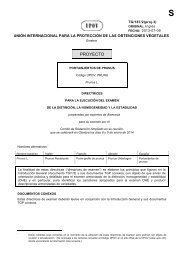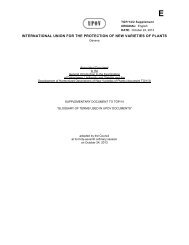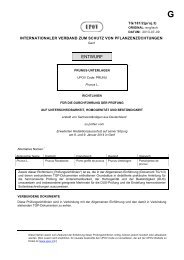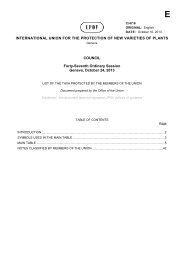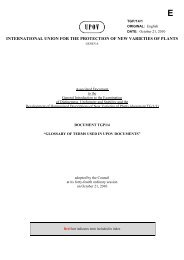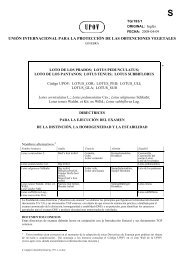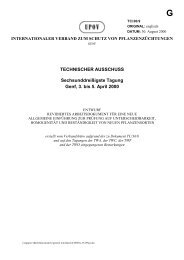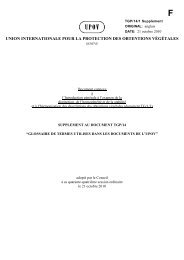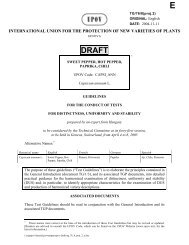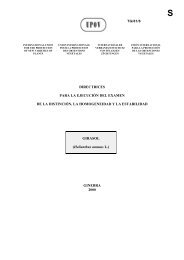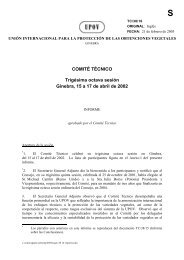Eruca sativa Mill. - International Union for the Protection of New ...
Eruca sativa Mill. - International Union for the Protection of New ...
Eruca sativa Mill. - International Union for the Protection of New ...
Create successful ePaper yourself
Turn your PDF publications into a flip-book with our unique Google optimized e-Paper software.
TG/ROCK_ERU(proj.2)<br />
ORIGINAL: English<br />
DATE: 2008-01-08<br />
INTERNATIONAL UNION FOR THE PROTECTION OF NEW VARIETIES OF PLANTS<br />
GENEVA<br />
DRAFT<br />
E<br />
CULTIVATED ROCKET<br />
*<br />
UPOV Code: ERUCA_SAT<br />
<strong>Eruca</strong> <strong>sativa</strong> <strong>Mill</strong>.<br />
GUIDELINES<br />
FOR THE CONDUCT OF TESTS<br />
FOR DISTINCTNESS, UNIFORMITY AND STABILITY<br />
prepared by experts from France<br />
to be considered by <strong>the</strong> Technical Committee at its <strong>for</strong>ty-fourth session,<br />
to be held in Geneva, from April 7 to 9, 2008<br />
Alternative Names: *<br />
Botanical name English French German Spanish<br />
<strong>Eruca</strong> <strong>sativa</strong> <strong>Mill</strong>. Arugula,<br />
Cultivated Rocket,<br />
Garden Rocket,<br />
Rocket-salad,<br />
Rugula,<br />
Salad Rocket<br />
Roquette cultivée Ölrauke, Rauke,<br />
Ruke, Rukola,<br />
Senfrauke<br />
Oruga común,<br />
Roqueta<br />
The purpose <strong>of</strong> <strong>the</strong>se guidelines (“Test Guidelines”) is to elaborate <strong>the</strong> principles contained in <strong>the</strong> General<br />
Introduction (document TG/1/3), and its associated TGP documents, into detailed practical guidance <strong>for</strong> <strong>the</strong><br />
harmonized examination <strong>of</strong> distinctness, uni<strong>for</strong>mity and stability (DUS) and, in particular, to identify appropriate<br />
characteristics <strong>for</strong> <strong>the</strong> examination <strong>of</strong> DUS and production <strong>of</strong> harmonized variety descriptions.<br />
ASSOCIATED DOCUMENTS<br />
These Test Guidelines should be read in conjunction with <strong>the</strong> General Introduction and its<br />
associated TGP documents.<br />
O<strong>the</strong>r associated UPOV documents: TG/ROCK-DIP<br />
*<br />
These names were correct at <strong>the</strong> time <strong>of</strong> <strong>the</strong> introduction <strong>of</strong> <strong>the</strong>se Test Guidelines but may be revised or updated.<br />
[Readers are advised to consult <strong>the</strong> UPOV Code, which can be found on <strong>the</strong> UPOV Website (www.upov.int), <strong>for</strong> <strong>the</strong><br />
latest in<strong>for</strong>mation.]<br />
n:\orgupov\shared\tg\rocket_eruca\upov drafts\tg_rock_eru_proj_2_22668_en.doc
TG/ROCK_ERU(proj.2)<br />
Cultivated Rock, 2008-01-08<br />
- 2 -<br />
TABLE OF CONTENTS<br />
PAGE<br />
1. SUBJECT OF THESE TEST GUIDELINES ....................................................................................................3<br />
2. MATERIAL REQUIRED ..................................................................................................................................3<br />
3. METHOD OF EXAMINATION........................................................................................................................3<br />
3.1 Number <strong>of</strong> Growing Cycles .......................................................................................................................3<br />
3.2 Testing Place ..............................................................................................................................................3<br />
3.3 Conditions <strong>for</strong> Conducting <strong>the</strong> Examination .............................................................................................3<br />
3.4 Test Design.................................................................................................................................................4<br />
3.5 Number <strong>of</strong> Plants / Parts <strong>of</strong> Plants to be Examined...................................................................................4<br />
3.6 Additional Tests .........................................................................................................................................4<br />
4. ASSESSMENT OF DISTINCTNESS, UNIFORMITY AND STABILITY....................................................4<br />
4.1 Distinctness.................................................................................................................................................4<br />
4.2 Uni<strong>for</strong>mity ..................................................................................................................................................5<br />
4.3 Stability.......................................................................................................................................................5<br />
5. GROUPING OF VARIETIES AND ORGANIZATION OF THE GROWING TRIAL .................................5<br />
6. INTRODUCTION TO THE TABLE OF CHARACTERISTICS.....................................................................6<br />
6.1 Categories <strong>of</strong> Characteristics .....................................................................................................................6<br />
6.2 States <strong>of</strong> Expression and Corresponding Notes.........................................................................................6<br />
6.3 Types <strong>of</strong> Expression...................................................................................................................................6<br />
6.4 Example Varieties ......................................................................................................................................6<br />
6.5 Legend ........................................................................................................................................................6<br />
7. TABLE OF CHARACTERISTICS/TABLEAU DES<br />
CARACTERES/MERKMALSTABELLE/TABLA DE CARACTERES........................................................7<br />
8. EXPLANATIONS ON THE TABLE OF CHARACTERISTICS..................................................................10<br />
8.1 Explanations covering several characteristics .........................................................................................10<br />
8.2 Explanations <strong>for</strong> individual characteristics..............................................................................................10<br />
9. LITERATURE..................................................................................................................................................13<br />
10. TECHNICAL QUESTIONNAIRE ..................................................................................................................14
1. Subject <strong>of</strong> <strong>the</strong>se Test Guidelines<br />
TG/ROCK_ERU(proj.2)<br />
Cultivated Rock, 2008-01-08<br />
- 3 -<br />
These Test Guidelines apply to all varieties <strong>of</strong> <strong>Eruca</strong> <strong>sativa</strong> <strong>Mill</strong>.<br />
2. Material Required<br />
2.1 The competent authorities decide on <strong>the</strong> quantity and quality <strong>of</strong> <strong>the</strong> plant material<br />
required <strong>for</strong> testing <strong>the</strong> variety and when and where it is to be delivered. Applicants<br />
submitting material from a State o<strong>the</strong>r than that in which <strong>the</strong> testing takes place must ensure<br />
that all customs <strong>for</strong>malities and phytosanitary requirements are complied with.<br />
2.2 The material is to be supplied in <strong>the</strong> <strong>for</strong>m <strong>of</strong> seed.<br />
2.3 The minimum quantity <strong>of</strong> plant material, to be supplied by <strong>the</strong> applicant, should be:<br />
25 g or 15 000 seeds.<br />
The seed should meet <strong>the</strong> minimum requirements <strong>for</strong> germination, species and analytical<br />
purity, health and moisture content, specified by <strong>the</strong> competent authority. In cases where <strong>the</strong><br />
seed is to be stored, <strong>the</strong> germination capacity should be as high as possible and should, be<br />
stated by <strong>the</strong> applicant.<br />
2.4 The plant material supplied should be visibly healthy, not lacking in vigor, nor<br />
affected by any important pest or disease.<br />
2.5 The plant material should not have undergone any treatment which would affect <strong>the</strong><br />
expression <strong>of</strong> <strong>the</strong> characteristics <strong>of</strong> <strong>the</strong> variety, unless <strong>the</strong> competent authorities allow or<br />
request such treatment. If it has been treated, full details <strong>of</strong> <strong>the</strong> treatment must be given.<br />
3. Method <strong>of</strong> Examination<br />
3.1 Number <strong>of</strong> Growing Cycles<br />
The minimum duration <strong>of</strong> tests should normally be two independent growing cycles.<br />
3.2 Testing Place<br />
Tests are normally conducted at one place. In <strong>the</strong> case <strong>of</strong> tests conducted at more than<br />
one place, guidance is provided in TGP/9 “Examining Distinctness”.<br />
3.3 Conditions <strong>for</strong> Conducting <strong>the</strong> Examination<br />
3.3.1 The tests should be carried out under conditions ensuring satisfactory growth <strong>for</strong> <strong>the</strong><br />
expression <strong>of</strong> <strong>the</strong> relevant characteristics <strong>of</strong> <strong>the</strong> variety and <strong>for</strong> <strong>the</strong> conduct <strong>of</strong> <strong>the</strong><br />
examination.<br />
3.3.2 The recommended method <strong>of</strong> observing <strong>the</strong> characteristic is indicated by <strong>the</strong> following<br />
key in <strong>the</strong> second column <strong>of</strong> <strong>the</strong> Table <strong>of</strong> Characteristics:
TG/ROCK_ERU(proj.2)<br />
Cultivated Rock, 2008-01-08<br />
- 4 -<br />
MG: single measurement <strong>of</strong> a group <strong>of</strong> plants or parts <strong>of</strong> plants<br />
MS: measurement <strong>of</strong> a number <strong>of</strong> individual plants or parts <strong>of</strong> plants<br />
VG: visual assessment by a single observation <strong>of</strong> a group <strong>of</strong> plants or parts <strong>of</strong> plants<br />
VS: visual assessment by observation <strong>of</strong> individual plants or parts <strong>of</strong> plants<br />
3.4 Test Design<br />
3.4.1 Each test should be designed to result in a total <strong>of</strong> at least 60 plants, which should be<br />
divided between two or more replicates.<br />
3.4.2 The design <strong>of</strong> <strong>the</strong> tests should be such that plants or parts <strong>of</strong> plants may be removed<br />
<strong>for</strong> measurement or counting without prejudice to <strong>the</strong> observations which must be made up to<br />
<strong>the</strong> end <strong>of</strong> <strong>the</strong> growing cycle.<br />
3.5 Number <strong>of</strong> Plants / Parts <strong>of</strong> Plants to be Examined<br />
Unless o<strong>the</strong>rwise indicated, all observations on single plants should be made on 20 plants or<br />
parts taken from each <strong>of</strong> 20 plants and any o<strong>the</strong>r observations made on all plants in <strong>the</strong> test.”<br />
3.6 Additional Tests<br />
Additional tests, <strong>for</strong> examining relevant characteristics, may be established.<br />
4. Assessment <strong>of</strong> Distinctness, Uni<strong>for</strong>mity and Stability<br />
4.1 Distinctness<br />
4.1.1 General Recommendations<br />
It is <strong>of</strong> particular importance <strong>for</strong> users <strong>of</strong> <strong>the</strong>se Test Guidelines to consult <strong>the</strong> General<br />
Introduction prior to making decisions regarding distinctness. However, <strong>the</strong> following points<br />
are provided <strong>for</strong> elaboration or emphasis in <strong>the</strong>se Test Guidelines.<br />
4.1.2 Consistent Differences<br />
The differences observed between varieties may be so clear that more than one<br />
growing cycle is not necessary. In addition, in some circumstances, <strong>the</strong> influence <strong>of</strong> <strong>the</strong><br />
environment is not such that more than a single growing cycle is required to provide<br />
assurance that <strong>the</strong> differences observed between varieties are sufficiently consistent. One<br />
means <strong>of</strong> ensuring that a difference in a characteristic, observed in a growing trial, is<br />
sufficiently consistent is to examine <strong>the</strong> characteristic in at least two independent growing<br />
cycles.<br />
4.1.3 Clear Differences<br />
Determining whe<strong>the</strong>r a difference between two varieties is clear depends on many<br />
factors, and should consider, in particular, <strong>the</strong> type <strong>of</strong> expression <strong>of</strong> <strong>the</strong> characteristic being<br />
examined, i.e. whe<strong>the</strong>r it is expressed in a qualitative, quantitative, or pseudo-qualitative<br />
manner. There<strong>for</strong>e, it is important that users <strong>of</strong> <strong>the</strong>se Test Guidelines are familiar with <strong>the</strong><br />
recommendations contained in <strong>the</strong> General Introduction prior to making decisions regarding<br />
distinctness.
TG/ROCK_ERU(proj.2)<br />
Cultivated Rock, 2008-01-08<br />
- 5 -<br />
4.2 Uni<strong>for</strong>mity<br />
4.2.1 It is <strong>of</strong> particular importance <strong>for</strong> users <strong>of</strong> <strong>the</strong>se Test Guidelines to consult <strong>the</strong> General<br />
Introduction prior to making decisions regarding uni<strong>for</strong>mity. However, <strong>the</strong> following points<br />
are provided <strong>for</strong> elaboration or emphasis in <strong>the</strong>se Test Guidelines:<br />
4.2.2 The assessment <strong>of</strong> uni<strong>for</strong>mity should be according to <strong>the</strong> recommendations <strong>for</strong><br />
cross-pollinated varieties in <strong>the</strong> General Introduction.<br />
4.3 Stability<br />
4.3.1 In practice, it is not usual to per<strong>for</strong>m tests <strong>of</strong> stability that produce results as certain as<br />
those <strong>of</strong> <strong>the</strong> testing <strong>of</strong> distinctness and uni<strong>for</strong>mity. However, experience has demonstrated<br />
that, <strong>for</strong> many types <strong>of</strong> variety, when a variety has been shown to be uni<strong>for</strong>m, it can also be<br />
considered to be stable.<br />
4.3.2 Where appropriate, or in cases <strong>of</strong> doubt, stability may be tested, ei<strong>the</strong>r by growing a<br />
fur<strong>the</strong>r generation, or by testing a new seed stock to ensure that it exhibits <strong>the</strong> same<br />
characteristics as those shown by <strong>the</strong> previous material supplied.<br />
5. Grouping <strong>of</strong> Varieties and Organization <strong>of</strong> <strong>the</strong> Growing Trial<br />
5.1 The selection <strong>of</strong> varieties <strong>of</strong> common knowledge to be grown in <strong>the</strong> trial with <strong>the</strong><br />
candidate varieties and <strong>the</strong> way in which <strong>the</strong>se varieties are divided into groups to facilitate<br />
<strong>the</strong> assessment <strong>of</strong> distinctness are aided by <strong>the</strong> use <strong>of</strong> grouping characteristics.<br />
5.2 Grouping characteristics are those in which <strong>the</strong> documented states <strong>of</strong> expression, even<br />
where produced at different locations, can be used, ei<strong>the</strong>r individually or in combination with<br />
o<strong>the</strong>r such characteristics: (a) to select varieties <strong>of</strong> common knowledge that can be excluded<br />
from <strong>the</strong> growing trial used <strong>for</strong> examination <strong>of</strong> distinctness; and (b) to organize <strong>the</strong> growing<br />
trial so that similar varieties are grouped toge<strong>the</strong>r.<br />
5.3 The following have been agreed as useful grouping characteristics:<br />
a) Leaf: length (characteristic 4)<br />
b) Leaf: width (characteristic 5)<br />
c) Leaf: division (characteristic 6)<br />
d) Leaf: secondary lobing (characteristic 8)<br />
e) Flower: color <strong>of</strong> petals (characteristic 13)<br />
5.4 Guidance <strong>for</strong> <strong>the</strong> use <strong>of</strong> grouping characteristics, in <strong>the</strong> process <strong>of</strong> examining<br />
distinctness, is provided through <strong>the</strong> General Introduction.
TG/ROCK_ERU(proj.2)<br />
Cultivated Rock, 2008-01-08<br />
- 6 -<br />
6. Introduction to <strong>the</strong> Table <strong>of</strong> Characteristics<br />
6.1 Categories <strong>of</strong> Characteristics<br />
6.1.1 Standard Test Guidelines Characteristics<br />
Standard Test Guidelines characteristics are those which are approved by UPOV <strong>for</strong><br />
examination <strong>of</strong> DUS and from which members <strong>of</strong> <strong>the</strong> <strong>Union</strong> can select those suitable <strong>for</strong> <strong>the</strong>ir<br />
particular circumstances.<br />
6.1.2 Asterisked Characteristics<br />
Asterisked characteristics (denoted by *) are those included in <strong>the</strong> Test Guidelines<br />
which are important <strong>for</strong> <strong>the</strong> international harmonization <strong>of</strong> variety descriptions and should<br />
always be examined <strong>for</strong> DUS and included in <strong>the</strong> variety description by all members <strong>of</strong> <strong>the</strong><br />
<strong>Union</strong>, except when <strong>the</strong> state <strong>of</strong> expression <strong>of</strong> a preceding characteristic or regional<br />
environmental conditions render this inappropriate.<br />
6.2 States <strong>of</strong> Expression and Corresponding Notes<br />
States <strong>of</strong> expression are given <strong>for</strong> each characteristic to define <strong>the</strong> characteristic and to<br />
harmonize descriptions. Each state <strong>of</strong> expression is allocated a corresponding numerical note<br />
<strong>for</strong> ease <strong>of</strong> recording <strong>of</strong> data and <strong>for</strong> <strong>the</strong> production and exchange <strong>of</strong> <strong>the</strong> description.<br />
6.3 Types <strong>of</strong> Expression<br />
An explanation <strong>of</strong> <strong>the</strong> types <strong>of</strong> expression <strong>of</strong> characteristics (qualitative, quantitative<br />
and pseudo-qualitative) is provided in <strong>the</strong> General Introduction.<br />
6.4 Example Varieties<br />
Where appropriate, example varieties are provided to clarify <strong>the</strong> states <strong>of</strong> expression <strong>of</strong><br />
each characteristic.<br />
6.5 Legend<br />
(*) Asterisked characteristic – see Chapter 6.1.2<br />
QL: Qualitative characteristic – see Chapter 6.3<br />
QN: Quantitative characteristic – see Chapter 6.3<br />
PQ: Pseudo-qualitative characteristic – see Chapter 6.3<br />
MG, MS, VG, VS: See Chapter 3.3.2<br />
(a) See Explanations on <strong>the</strong> Table <strong>of</strong> Characteristics in Chapter 8.1<br />
(+) See Explanations on <strong>the</strong> Table <strong>of</strong> Characteristics in Chapter 8.2
TG/ROCK_ERU(proj.2)<br />
Cultivated Rock, Roquette cultivée, Ölrauke, Roqueta, 2008-01-08<br />
- 7 -<br />
7. Table <strong>of</strong> Characteristics/Tableau des caractères/Merkmalstabelle/Tabla de caracteres<br />
English français Deutsch español<br />
1. VG Leaf: attitude Feuille : port Blatt: Haltung Hoja: porte<br />
Example Varieties/<br />
Exemples/<br />
Beispielssorten/<br />
Variedades ejemplo<br />
Note/<br />
Nota<br />
QN (a) erect dressé aufrecht erecto Runway, Sky Rocket 1<br />
semi erect demi dressé halbaufrecht semi erecto Myway 3<br />
horizontal horizontal waagerecht horizontal Highway 5<br />
2.<br />
(*)<br />
VG Leaf: color <strong>of</strong> blade<br />
Feuille : couleur du<br />
limbe<br />
Blatt: Farbe der<br />
Spreite<br />
Hoja: color del<br />
limbo<br />
QL (a) yellow green vert jaune gelbgrün amarillo verde Highway, Runway 1<br />
green vert grün verde Myway 2<br />
3. VG Leaf: intensity <strong>of</strong><br />
color<br />
Feuile: intensité de la<br />
couleur<br />
Blatt: Intensität der<br />
Farbe<br />
Hoja: intensidad<br />
del color<br />
QN (a) light claire hell claro 3<br />
medium moyenne mittel medio 5<br />
dark foncée dunkel oscuro 7<br />
4.<br />
(*)<br />
(+)<br />
VG/<br />
MG<br />
Leaf: length Feuille: longueur Blatt: Länge Hoja: longitud<br />
QN (a) short courte kurz corta Rococo 3<br />
medium moyenne mittel media Myway 5<br />
long longue lang larga Runway 7<br />
5.<br />
(*)<br />
VG/<br />
MG<br />
Leaf: width Feuille: largeur Blatt: Breite Hoja: anchura<br />
QN (a) narrow étroit schmal estrecha 3<br />
medium moyenne mittel media Myway 5<br />
broad large breit ancha Highway 7
TG/ROCK_ERU(proj.2)<br />
Cultivated Rock, Roquette cultivée, Ölrauke, Roqueta, 2008-01-08<br />
- 8 -<br />
English français Deutsch español<br />
Example Varieties/<br />
Exemples/<br />
Beispielssorten/<br />
Variedades ejemplo<br />
Note/<br />
Nota<br />
6.<br />
(*)<br />
(+)<br />
VG Leaf: division Feuille: découpe Blatt: Fiederung Hoja: división<br />
QN (a) absent or very weak absente ou très faible fehlend oder sehr<br />
gering<br />
ausente o muy débil Apollo 1<br />
weak faible gering débil Aladin 3<br />
moderate moyenne mittel mediana Rococo 5<br />
strong <strong>for</strong>te stark fuerte Myway 7<br />
very strong très <strong>for</strong>te sehr stark muy fuerte Runway 9<br />
7.<br />
(+)<br />
VG Leaf: width <strong>of</strong><br />
primary lobes<br />
Feuille: largeur des<br />
lobes primaires<br />
Blatt: Breite der<br />
Lappen erster<br />
Ordnung<br />
Hoja: anchura de<br />
los lóbulos<br />
principales<br />
QN (a) narrow étroite schmal estrecha Runway 3<br />
medium moyenne mittel media Highway 5<br />
broad large breit ancha Rococo 7<br />
8.<br />
(*)<br />
(+)<br />
VG Leaf: secondary<br />
lobing<br />
Feuille: découpe<br />
secondaire<br />
Blatt: Lappung<br />
zweiter Ordnung<br />
Hoja: lobulado<br />
secundario<br />
QN (a) absent or very weak absente ou très faible fehlend oder sehr<br />
gering<br />
ausente o muy débil Aladin 1<br />
weak faible gering débil 3<br />
moderate moyenne mittel medio Rococo 5<br />
strong <strong>for</strong>te stark fuerte Myway 7<br />
very strong très <strong>for</strong>te sehr stark muy fuerte Highway, Runway 9<br />
9. VG Leaf: undulation <strong>of</strong><br />
margin<br />
Feuille: ondulation du<br />
bord<br />
Blatt: Randwellung Hoja: ondulación<br />
del borde<br />
QN (a) weak faible gering débil Highway 3<br />
medium moyenne mittel media Rococo 5<br />
strong <strong>for</strong>te stark fuerte Myway 7
TG/ROCK_ERU(proj.2)<br />
Cultivated Rock, Roquette cultivée, Ölrauke, Roqueta, 2008-01-08<br />
- 9 -<br />
English français Deutsch español<br />
10. VG Leaf: hairiness Feuille: pilosité Blatt: Behaarung Hoja: vellosidad<br />
Example Varieties/<br />
Exemples/<br />
Beispielssorten/<br />
Variedades ejemplo<br />
Note/<br />
Nota<br />
QN (a) weak faible gering débil Highway 3<br />
medium moyenne mittel media Sky Rocket 5<br />
strong <strong>for</strong>te stark fuerte 7<br />
11.<br />
(*)<br />
(+)<br />
VG/<br />
MG<br />
Time <strong>of</strong> flowering Epoque de floraison Zeitpunkt der Blüte Época de floración<br />
QN early précoce früh temprana Astro 3<br />
medium moyenne mittel media Highway 5<br />
late tardive spät tardía Runway 7<br />
very late très tardive sehr spät muy tardía Sky Rocket 9<br />
12. VG Plant: height at<br />
flowering stage<br />
Plante: hauteur au<br />
stade floraison<br />
Pflanze: Höhe im<br />
Blühstadium<br />
Planta: altura en<br />
floración<br />
QN short courte niedrig baja 3<br />
medium moyenne mittel media Rococo 5<br />
long longue hoch alta Highway 7<br />
13.<br />
(*)<br />
(+)<br />
VG Flower: color <strong>of</strong> petals Fleur: couleur des<br />
pétales<br />
Blüte: Farbe der<br />
Blütenblätter<br />
Flor: color de los<br />
pétalos<br />
PQ whitish blanchâtre weißlich blanquecino Rococo 1<br />
creamish blanc jaunâtre cremefarben cremoso Myway 2<br />
light yellow jaune pâle hellgelb amarillo claro Highway 3<br />
14. VG Flower: anthocyanin<br />
coloration <strong>of</strong> vein<br />
Fleur: coloration<br />
anthocyanique des<br />
nervures<br />
Blüte:<br />
Anthocyanfärbung<br />
der Ader<br />
Flor: coloración<br />
antoaciánica de los<br />
nervios<br />
QN absent or weak absente à faible fehlend oder gering ausente o débil Flash 1<br />
medium moyenne mittel media Highway 2<br />
strong <strong>for</strong>te stark fuerte Rococo 3
TG/ROCK_ERU(proj.2)<br />
Cultivated Rock, 2008-01-08<br />
- 10 -<br />
8. Explanations on <strong>the</strong> Table <strong>of</strong> Characteristics<br />
8.1 Explanations covering several characteristics<br />
Characteristics containing <strong>the</strong> following key in <strong>the</strong> second column <strong>of</strong> <strong>the</strong> Table <strong>of</strong><br />
Characteristics should be examined as indicated below:<br />
(a)<br />
All observation on <strong>the</strong> leaf should be made on <strong>the</strong> rosette be<strong>for</strong>e <strong>the</strong> appearance<br />
<strong>of</strong> <strong>the</strong> inflorescence.<br />
8.2 Explanations <strong>for</strong> individual characteristics<br />
Ad. 4: Leaf: length<br />
The leaf length includes <strong>the</strong> blade and petiole.<br />
Ad. 6: Leaf: division<br />
1 3 5 7 9<br />
absent or very<br />
weak<br />
weak medium strong very strong<br />
The division <strong>of</strong> <strong>the</strong> leaf should be observed in <strong>the</strong> middle third <strong>of</strong> <strong>the</strong> leaf.
Ad. 7: Leaf: width <strong>of</strong> primary lobes<br />
TG/ROCK_ERU(proj.2)<br />
Cultivated Rock, 2008-01-08<br />
- 11 -<br />
The width <strong>of</strong> <strong>the</strong> primary lobes should be observed in <strong>the</strong> middle third <strong>of</strong> <strong>the</strong> leaf.<br />
Ad. 8: Leaf: secondary lobing<br />
primary lobe<br />
secondary lobe<br />
3 5 7<br />
weak moderate strong<br />
Ad. 11: Time <strong>of</strong> flowering<br />
The time <strong>of</strong> flowering is when 50% <strong>of</strong> plants have at least one open flower.
TG/ROCK_ERU(proj.2)<br />
Cultivated Rock, 2008-01-08<br />
- 12 -<br />
Ad. 13: Flower: color <strong>of</strong> petals<br />
The color <strong>of</strong> <strong>the</strong> petals should be observed at <strong>the</strong> time <strong>of</strong> flower opening.
TG/ROCK_ERU(proj.2)<br />
Cultivated Rock, 2008-01-08<br />
- 13 -<br />
9. Literature<br />
IPGRI, 1999: Descriptors <strong>for</strong> Rocket (<strong>Eruca</strong> spp.). <strong>International</strong> Plant Genetic Resources<br />
Institute, Rome, IT, 56 pp.<br />
Padulosi, S., Pignone, D., editors, 1997: Rocket: a Mediterranean crop <strong>for</strong> <strong>the</strong> world. Report<br />
<strong>of</strong> a workshop, 13-14 December 1996, Legnaro, IT. <strong>International</strong> Plant Genetic Resources<br />
Institute, Rome, IT, 97 pp.
TG/ROCK_ERU(proj.2)<br />
Cultivated Rock, 2008-01-08<br />
- 14 -<br />
10. Technical Questionnaire<br />
TECHNICAL QUESTIONNAIRE Page {x} <strong>of</strong> {y} Reference Number:<br />
TECHNICAL QUESTIONNAIRE<br />
Application date:<br />
(not to be filled in by <strong>the</strong><br />
applicant)<br />
to be completed in connection with an application <strong>for</strong> plant breeders’ rights<br />
1. Subject <strong>of</strong> <strong>the</strong> Technical Questionnaire<br />
1.1 Botanical name <strong>Eruca</strong> <strong>sativa</strong> <strong>Mill</strong>.<br />
1.2 Common name Cultivated rocket<br />
2. Applicant<br />
Name<br />
Address<br />
Telephone No.<br />
Fax No.<br />
E-mail address<br />
Breeder (if different from applicant)<br />
3. Proposed denomination and breeder’s reference<br />
Proposed denomination<br />
(if available)<br />
Breeder’s reference
TG/ROCK_ERU(proj.2)<br />
Cultivated Rock, 2008-01-08<br />
- 15 -<br />
TECHNICAL QUESTIONNAIRE Page {x} <strong>of</strong> {y} Reference Number:<br />
# 4. In<strong>for</strong>mation on <strong>the</strong> breeding scheme and propagation <strong>of</strong> <strong>the</strong> variety<br />
4.1 Breeding scheme<br />
Variety resulting from:<br />
4.1.1 Crossing<br />
(a) controlled cross [ ]<br />
(please state parent varieties)<br />
(b) partially known cross [ ]<br />
(please state known parent variety(ies))<br />
(c) unknown cross [ ]<br />
4.1.2 Mutation [ ]<br />
(please state parent variety)<br />
4.1.3 Discovery and development [ ]<br />
(please state where and when discovered<br />
and how developed)<br />
4.1.4 O<strong>the</strong>r [ ]<br />
(please provide details)<br />
4.2 Method <strong>of</strong> propagating <strong>the</strong> variety<br />
(a)<br />
Cross-pollination<br />
(i) population [ ]<br />
(ii) syn<strong>the</strong>tic variety [ ]<br />
(b) O<strong>the</strong>r [ ]<br />
(please provide details)<br />
#<br />
Authorities may allow certain <strong>of</strong> this in<strong>for</strong>mation to be provided in a confidential section <strong>of</strong> <strong>the</strong> Technical<br />
Questionnaire.
TG/ROCK_ERU(proj.2)<br />
Cultivated Rock, 2008-01-08<br />
- 16 -<br />
TECHNICAL QUESTIONNAIRE Page {x} <strong>of</strong> {y} Reference Number:<br />
5. Characteristics <strong>of</strong> <strong>the</strong> variety to be indicated (<strong>the</strong> number in brackets refers to <strong>the</strong><br />
corresponding characteristic in Test Guidelines; please mark <strong>the</strong> note which best corresponds).<br />
Characteristics Example Varieties Note<br />
5.1<br />
(4)<br />
Leaf: length<br />
short Rococo 3 [ ]<br />
medium Myway 5 [ ]<br />
long Runway 7 [ ]<br />
5.2<br />
(5)<br />
Leaf: width<br />
narrow 3 [ ]<br />
medium Myway 5 [ ]<br />
broad Highway 7 [ ]<br />
5.3<br />
(6)<br />
Leaf: division<br />
absent or very weak Apollo 1 [ ]<br />
weal Aladin 3 [ ]<br />
medium Rococo 5 [ ]<br />
strong Myway 7 [ ]<br />
very strong Runway 9 [ ]<br />
5.4<br />
(8)<br />
Leaf: secondary lobing<br />
absent or very weak Aladin 1 [ ]<br />
weak 3 [ ]<br />
medium Rococo 5 [ ]<br />
strong Myway 7 [ ]<br />
very strong Highway, Runway 9 [ ]
TG/ROCK_ERU(proj.2)<br />
Cultivated Rock, 2008-01-08<br />
- 17 -<br />
TECHNICAL QUESTIONNAIRE Page {x} <strong>of</strong> {y} Reference Number:<br />
Characteristics Example Varieties Note<br />
5.5<br />
(11)<br />
Time <strong>of</strong> flowering<br />
early Astro 3 [ ]<br />
medium Highway 5 [ ]<br />
late Runway 7 [ ]<br />
very late Sky Rocket 9 [ ]<br />
5.6<br />
(13)<br />
Flower: color <strong>of</strong> petals<br />
whitish Rococo 1 [ ]<br />
creamish Myway 2 [ ]<br />
light yellow Highway 3 [ ]
TG/ROCK_ERU(proj.2)<br />
Cultivated Rock, 2008-01-08<br />
- 18 -<br />
TECHNICAL QUESTIONNAIRE Page {x} <strong>of</strong> {y} Reference Number:<br />
6. Similar varieties and differences from <strong>the</strong>se varieties<br />
Please use <strong>the</strong> following table and box <strong>for</strong> comments to provide in<strong>for</strong>mation on how your<br />
candidate variety differs from <strong>the</strong> variety (or varieties) which, to <strong>the</strong> best <strong>of</strong> your knowledge,<br />
is (or are) most similar. This in<strong>for</strong>mation may help <strong>the</strong> examination authority to conduct its<br />
examination <strong>of</strong> distinctness in a more efficient way.<br />
Denomination(s) <strong>of</strong><br />
variety(ies) similar to<br />
your candidate variety<br />
Characteristic(s) in<br />
which your candidate<br />
variety differs from <strong>the</strong><br />
similar variety(ies)<br />
Describe <strong>the</strong><br />
expression <strong>of</strong> <strong>the</strong><br />
characteristic(s) <strong>for</strong><br />
<strong>the</strong> similar<br />
variety(ies)<br />
Describe <strong>the</strong> expression<br />
<strong>of</strong> <strong>the</strong> characteristic(s)<br />
<strong>for</strong> your candidate<br />
variety<br />
Example Flower: color <strong>of</strong> petals whitish light yellow<br />
Comments:
TG/ROCK_ERU(proj.2)<br />
Cultivated Rock, 2008-01-08<br />
- 19 -<br />
TECHNICAL QUESTIONNAIRE Page {x} <strong>of</strong> {y} Reference Number:<br />
# 7. Additional in<strong>for</strong>mation which may help in <strong>the</strong> examination <strong>of</strong> <strong>the</strong> variety<br />
7.1 In addition to <strong>the</strong> in<strong>for</strong>mation provided in sections 5 and 6, are <strong>the</strong>re any additional<br />
characteristics which may help to distinguish <strong>the</strong> variety?<br />
Yes [ ] No [ ]<br />
(If yes, please provide details)<br />
7.2 Are <strong>the</strong>re any special conditions <strong>for</strong> growing <strong>the</strong> variety or conducting <strong>the</strong> examination?<br />
Yes [ ] No [ ]<br />
(If yes, please provide details)<br />
8. Authorization <strong>for</strong> release<br />
(a) Does <strong>the</strong> variety require prior authorization <strong>for</strong> release under legislation concerning<br />
<strong>the</strong> protection <strong>of</strong> <strong>the</strong> environment, human and animal health?<br />
Yes [ ] No [ ]<br />
(b)<br />
Has such authorization been obtained?<br />
Yes [ ] No [ ]<br />
If <strong>the</strong> answer to (b) is yes, please attach a copy <strong>of</strong> <strong>the</strong> authorization.<br />
#<br />
Authorities may allow certain <strong>of</strong> this in<strong>for</strong>mation to be provided in a confidential section <strong>of</strong> <strong>the</strong> Technical<br />
Questionnaire.
TG/ROCK_ERU(proj.2)<br />
Cultivated Rock, 2008-01-08<br />
- 20 -<br />
TECHNICAL QUESTIONNAIRE Page {x} <strong>of</strong> {y} Reference Number:<br />
9. In<strong>for</strong>mation on plant material to be examined or submitted <strong>for</strong> examination.<br />
9.1 The expression <strong>of</strong> a characteristic or several characteristics <strong>of</strong> a variety may be affected<br />
by factors, such as pests and disease, chemical treatment (e.g. growth retardants or pesticides),<br />
effects <strong>of</strong> tissue culture, different rootstocks, scions taken from different growth phases <strong>of</strong> a<br />
tree, etc.<br />
9.2 The plant material should not have undergone any treatment which would affect <strong>the</strong><br />
expression <strong>of</strong> <strong>the</strong> characteristics <strong>of</strong> <strong>the</strong> variety, unless <strong>the</strong> competent authorities allow or<br />
request such treatment. If <strong>the</strong> plant material has undergone such treatment, full details <strong>of</strong> <strong>the</strong><br />
treatment must be given. In this respect, please indicate below, to <strong>the</strong> best <strong>of</strong> your knowledge,<br />
if <strong>the</strong> plant material to be examined has been subjected to:<br />
(a) Microorganisms (e.g. virus, bacteria, phytoplasma) Yes [ ] No [ ]<br />
(b) Chemical treatment (e.g. growth retardant, pesticide) Yes [ ] No [ ]<br />
(c) Tissue culture Yes [ ] No [ ]<br />
(d) O<strong>the</strong>r factors Yes [ ] No [ ]<br />
Please provide details <strong>for</strong> where you have indicated “yes”.<br />
……………………………………………………………<br />
10. I hereby declare that, to <strong>the</strong> best <strong>of</strong> my knowledge, <strong>the</strong> in<strong>for</strong>mation provided in this <strong>for</strong>m<br />
is correct:<br />
Applicant’s name<br />
Signature<br />
Date<br />
[End <strong>of</strong> document]



